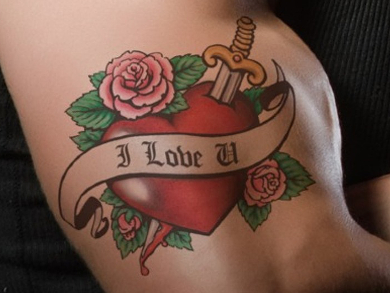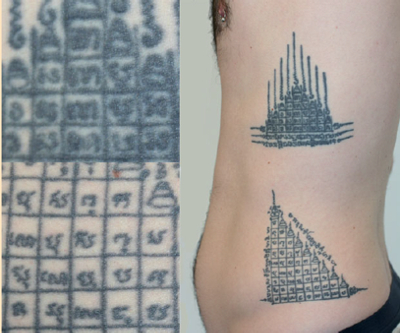Henrik Petersen and Klaus Roth, authors of To Tattoo or Not to Tattoo, talked to Marcel Tritsch, MT Derm GmbH, Berlin, Germany. MT Derm produces tattooing machines and supplies, including coloring materials. Mr. Tritsch is involved in quality control, and responsible for maintenance for all products with relevant EU guidelines.
How did you come to acquire your very first tattoo?
That was a long time ago! I was 24 years old and had for a long time had the idea of getting tattooed. It was a decision to which I had given considerable thought. I envisioned something involving Easter roses because I am especially fond of these flowers. Then I sought out a tattooist with a good reputation, one who knew something about flowers.
I began by talking over with him what I envisioned. It was supposed to be a tattoo on my lower leg, and he scribbled a first sketch, which we then further developed. At our second meeting, he presented me with a design that included a marvelous group of Easter roses in bloom, which after a few minor modifications, I accepted. It was then that the actual process of tattooing began, which – over the course of three sittings – took a total of about 24 hours.
Did you find the tattooing process to be painful?
Yes, indeed! The level of pain depends on the part of the body involved. In the case of the lower leg, I didn’t find it to be too bad. It is similar to someone poking a knitting needle through a part of the skin that already suffered from a serious sunburn.
Many people with tattoos say that tolerating the pain is an important aspect of getting a tattoo, almost an exciting experience.
Yes, many do allege that it is important, a feature that certainly belongs to the process, and that has a meditative aspect to it. I personally don’t agree; I would rather do without the pain. I am more interested in the work of art – one with which I wish to identify for my entire life.
Suppose you later regret your decision; have you already thought about perhaps having the tattoo removed?
No, absolutely not! But I very deliberately considered only motifs that I would still be comfortable with in 50 years. An Easter rose will always be beautiful. Opinions can and may always change in the course of a life, sometimes to the exact opposite. That’s why I would never allow myself to be tattooed with a political declaration or a person’s name.
In the future, your skin will certainly undergo changes, and your Easter rose may well no longer look so splendid. Have you thought about that?
Of course! But to begin with, my tattoos are located in places that are normally covered by clothing. I’m the only one that decides if they are visible. If my skin ages in the future and becomes wrinkled, it will naturally be less attractive than it is now, and the same applies to my tattoos. That’s just the way it is, and I don’t see that it poses any problems for me. But in no case would I rule out tattoos from the outset on that basis.
Let’s talk about the two tattoos on your upper body. Can you tell us more about how they originated?
Gladly. Both came to be while I was spending several months in Thailand. In Koh-Tao, I got to know a traditional tattooist and spent a long time conversing with him about the history of this art form and its spiritual significance. I had already decided to acquire a Thai tattoo, but I didn’t yet know exactly what it should be. It was not until this conversation that I decided I wanted a traditional tattoo: one that would both be a lucky charm and always serve as a reminder for me personally of this very important time in Thailand. A few days later around noontime, I showed up at the tattooist’s, and let him apply this tattoo, which was supposed to confer Buddha’s protection upon me.
How did the procedure in Thailand differ from that used by a modern tattooist here?
In many studios here one feels almost like one is in a dentist’s office. There the environment was very simple, but certainly not dirty. Through our preliminary talk, I had gained confidence in the tattooist and was very relaxed. Quite calmly he stirred up black pigment in a small dish and set about his work. He didn’t use a modern tattooing device, but rather a long bamboo stick with two or three needles jammed into the end. He dipped these into the pigment and then drove them into the skin, by pushing on the other end of the stick.
|
|
|
Tattoos prepared by different techniques. Both tattoos were applied in the same month. Top: applied in the traditional way, by hand with a tattooing stick; bottom: applied with a modern tattooing device. From the standpoint of sharpness, use of the professional device is better than manual application. Magnification (left) makes the differences clear. |
That sounds terrible! Didn’t it hurt?
On the contrary! It felt soothing. I felt no pain, it rather felt like pins and needles. Surprisingly, this method felt quite non-invasive to me. After only a few days, I was able to tolerate salt water on the respective areas of the skin, while after a tattoo made with a machine one has to be cautious much longer and follow an intensive skin care routine.
But didn’t you perceive the external conditions as quite risky?
Well, today I would probably not do it again. But I am now much better informed about the risks and what I should pay attention to.
Your second Thai tattoo looks quite similar to the first. What is the difference?
The second tattoo is a general lucky charm. I’m double-protected, so to speak. This second tattoo was created by another Thai tattoo artist, but this time with a machine. The difference: The hand-struck tattoo took an hour and a half, with the machine, it only took 20 minutes. When looking closely, a huge difference can be seen. A tattoo artist can draw very precise lines with a machine, e.g. write a text. By comparison, the hand-pierced tattoo looks a bit blurry. In this particular case, this is, at least for me, absolutely unimportant, but you see what a progress the machines brought and why so extremely finely structured tattoos can be made today. The machines are really a quantum leap for the artistically ambitious tattoo artist.
With your current knowledge and experience, what would you recommend to people who are serious about getting a tattoo?
I would like to be cautious with recommendations because a tattoo is a very personal matter. But no matter what you decide, a thought process should always precede a tattoo. I would not run with a picture to the first tattooist and say: This is exactly what I would like.
For a real good tattoo it is not enough if some tattoo artist just starts somehow and sticks something into the skin. First, you should build a trusting relationship with the tattooist. This starts with the hygienic work in a clean studio, but above all, you have to be convinced of the craftsmanship and artistic skills of the tattooist. A good tattoo artist also knows what he can and cannot do and answers questions about his skills.
After a longer preliminary talk, the tattoo artist knows what you want and why and can make suggestions. The tattoo artist also needs artistic design freedom and one should therefore not save on the fee. Fees are 80–100 euros per hour; but there is no real upper limit. I would never go to an amateur because the result is on your body for a lifetime. This must be borne in mind; and good tattooists are, of course, aware of their responsibilities.
>> Back to the article: To Tattoo or Not to Tattoo?





